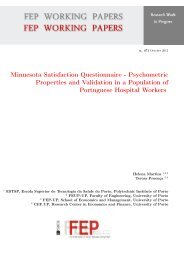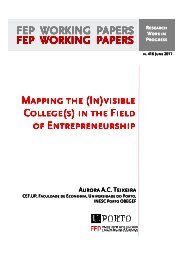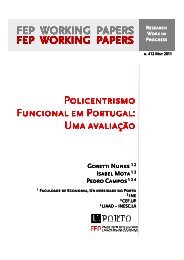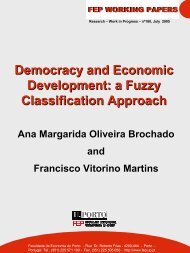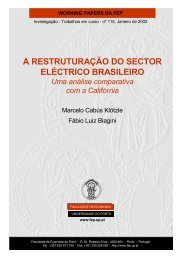FEP - Working Papers - Universidade do Porto
FEP - Working Papers - Universidade do Porto
FEP - Working Papers - Universidade do Porto
Create successful ePaper yourself
Turn your PDF publications into a flip-book with our unique Google optimized e-Paper software.
therefore, are more effective in deterring entry. Shopping malls would be driven out of<br />
the market by department stores because when there is competition between department<br />
stores and shopping malls, the former have higher profits.<br />
We also compare the consumers’ surplus and the total surplus in the different scenarios<br />
of retail organization. Since all the consumers are assumed to buy exactly one unit of<br />
each good, a change in prices simply transfers surplus between consumers and producers.<br />
Therefore, total surplus is maximized when consumers shop at the closest shopping center<br />
(transportation costs are minimized). This occurs when there are either two department<br />
stores or two shopping malls. Unsurprinsingly, the consumers’ surplus is the highest in the<br />
case of competition between two department stores. The equilibrium of the merger game<br />
(two shopping malls) is actually the worst scenario for consumers. In spite of having to<br />
support higher transportation costs, consumers are better off when there is a department<br />
store and a shopping mall than when there are two shopping malls.<br />
Our model is pioneer in extending the spatial competition model (Hotelling, 1929;<br />
d’Aspremont, Gabszewicz and Thisse, 1979) to analyze multi-product competition be-<br />
tween department stores and shopping malls. To the best of our knowledge, only Lal and<br />
Matutes (1989) have presented a multi-product version of the model of Hotelling (1929). 5<br />
They restricted the analysis to the case of competition between two department stores that<br />
sell two goods. We have greatly generalized their analysis by allowing a finite number of<br />
goods and an alternative mode of retail: the shopping mall. 6<br />
Other authors have analyzed multi-product price competition, but no one used the<br />
spatial competition model to <strong>do</strong> so. Moreover, most of them based the analysis on the<br />
assumption that consumers make all their purchases at the same shopping center (Bliss,<br />
1988; Beggs, 1994; Smith and Hay, 2005; Innes, 2006). They support this “one stop<br />
shopping” assumption on the fact that shopping implies time and transportation costs.<br />
They argue that, in order to save costs, customers make all their purchases at the same<br />
5 There are other extensions of the spatial competition model that allow for multi-product firms, but<br />
in which consumers only buy one of the goods that are available (Laussel, 2006; Giraud-Heraud, Hammoudi<br />
and Mokrane, 2003). Goods available in a shopping center are, in this case, substitutes instead of<br />
complements. These models correspond to completely different economic settings.<br />
6 In the model of Lal and Matutes (1989), there are two types of consumers: the poor and the rich. The<br />
poor <strong>do</strong> not support transportation costs, therefore, they buy each good where it is cheaper (“one stop<br />
shopping” is not assumed). The rich, on the other hand, support transportation costs and, in equilibrium,<br />
are not interested in shopping around. Their focus is to study price discrimination across the two segments.<br />
5



